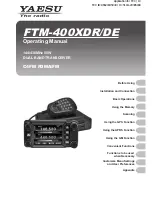
©1998 Hamtronics, Inc.; Hilton NY; USA. All rights reserved. Hamtronics is a registered trademark. Revised: 12/11/02
- Page 1 -
GENERAL INFORMATION.
There are some jobs a transceiver
grade receiver just can't do, at least
not well. That's where reliable Ham-
tronics® commercial quality receivers
come in!
The R301 is the latest in a series of
popular receivers for demanding ap-
plications which require exceptional
sensitivity and selectivity. It is espe-
cially suited for repeaters, audio and
data links, and remote control. The
R301 was designed to provide instant
setup without lengthy waits to obtain
channel crystals. It is a single-
channel vhf fm receiver available in
several models for reception in the
144 MHz ham band, the 148-174
MHz commercial band, or 216-226
MHz.
The R301 is our 7th generation vhf
fm receiver, and it packs in features
you've told us are important to you
during our 35 years of designing re-
ceivers. It's up to the difficult jobs
you've told us you have.
The R301 retains all of the popular
features Hamtronics
®
receivers have
been noted for. It uses triple-tuned
circuits in the front end and excellent
crystal and ceramic filters in the i-f
with steep skirts for close channel
spacing or repeater operation. The i-f
selectivity, for instance, is down over
100dB at ±12 kHz away from the car-
rier, which is 40-50 dB better than
most transceivers. Low noise fet's in
the front end provide good overload
resistance and excellent sensitivity.
The R301 is designed for narrow-
band fm with ±5 kHz deviation. The
audio output will drive any load as low
as 8
Ω
with up to 1 Watt continuous
output or 2 Watts intermittent output.
The receiver may be used with either
voice or fsk data up to 9600 baud us-
ing an external data interface unit.
An accessory TD-5 CTCSS Decoder
unit is available for subaudible tone
control.
The R301 features a new positive-
acting, wide-range squelch circuit and
additional output terminals for low-
level squelched audio and discrimina-
tor audio as well as COS.
There are several models, which
have minor variations in parts and
microcontroller programming, to pro-
vide coverage as shown in table 1.
Channel frequency is controlled by a
synthesizer with DIP switch channel
setting.
The TCXO (temperature controlled
xtal oscillator) provides a temperature
stability of ±2ppm over a temperature
range of -30°C to +60°C.
INSTALLATION.
Mounting.
Some form of support should be
provided under the pc board, gener-
ally mounting the board with spacers
to a chassis. 3/8-inch holes should
be provided in a front panel for the
bushings of the SQUELCH and VOL-
UME controls. After sliding bushings
through panel, washers and nuts can
be installed on the outside of the
panel. Be sure to provide support for
the board; do not rely on the controls
to support the board, since that could
cause a break in the pcb solder con-
nections.
The receiver board relies on the
mounting hardware to provide the dc
and speaker ground connections to
the ground plane on the board; so
metal standoffs and screws should be
used for mounting.
Note that an er-
ror on the boards covered the
mounting pads with solder mask;
so scrape the mask off one of the
mounting pads to get a good
ground connection through the
hardware.
Electrical Connections.
Power and input audio or data sig-
nals should be connected to the solder
pads on the pc board with #22 solid
hookup wire, which can be attached
to a connector or feedthrough capaci-
tors used on the cabinet in which it is
installed. Be very careful not to route
the wiring near the components on
the left hand side of the board, which
contains sensitive loop filter and vco
circuits which could pick up noise
from the wiring.
Power Connections.
The receiver operates on +13.6 Vdc
at about 200 mA peak with full audio.
Current drain with no audio is only
about 55 mA. A well regulated power
supply should be used.
Be sure that the power source does
not carry high voltage or reverse po-
larity transients on the line, since
semiconductors in the receiver can be
damaged. The positive power supply
lead should be connected to the re-
ceiver at terminal E3, and the nega-
tive power lead should be connected
to the ground plane of the board
through the mounting hardware or
the shield of the coaxial cable. Be
sure to observe polarity!
Speaker.
An 8-ohm loudspeaker should be
connected to E2 with ground return
through the mounting hardware. Use
of lower impedance speaker or short-
ing of speaker terminal can result in
ic damage. The receiver can also drive
higher impedances, such as the 1K to
20K input impedances of repeater
controller boards. There is no need to
load down the output to 8 ohms.
0
Note that the audio output ic is
designed to be heatsunk to the pc
board through the many ground pins
on the ic. When running moderately
low audio levels as most applications
require, it is no problem to use an ic
socket; so we have provided one for
your convenience. If you will be run-
ning high audio levels, check to see if
the ic is getting hot. If so, you should
remove the ic socket, and solder the
LM-380N-8 ic directly to the board for
better heatsinking.
HAMTRONICS® R301 VHF FM RECEIVER, REV C:
INSTALLATION, OPERATION, & MAINTENANCE
Table 1. Quick Specification Reference
Model R301-1
138.000 - 148.235 MHz
Model R301-2
144.000 - 154.235 MHz
Model R301-3
154.200 - 164.435 MHz
Model R301-4
164.400 - 174.635 MHz
Model R301-5
216.000 - 226.235 MHz
Model R301-6
220.000 - 230.235 MHz
Sensitivity
(12dB SINAD): 0.15 to 0.2µV
Squelch Sensitivity:
0.1µV
Adjacent Channel Selectivity:
±12 kHz at -100dB!
Image Rejection:
60-70dB
Modulation Acceptance:
±7.5 kHz
Frequency Stability:
±2ppm -30°C to +60°C
Audio Output:
up to 2 Watts (8 ohms).
Operating Power:
+13.6Vdc at 55-200 mA,
depending on audio level.
Size:
4 in. W x 3-7/16 in. D (plus pot. shafts)
HOW TO CONTACT US —
Hamtronics, Inc.
65 Moul Rd; Hilton NY 14468-9535
Phone: 585-392-9430
http://www.hamtronics.com
email: [email protected]



























